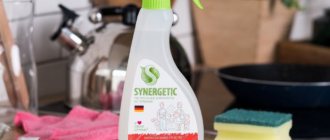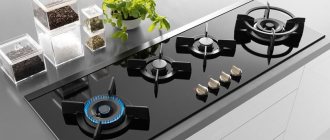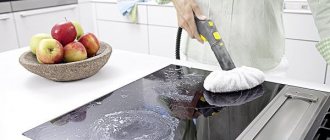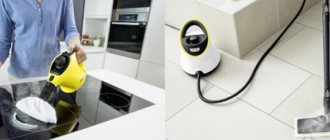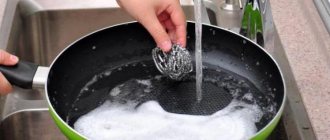To keep your hob as beautiful as when you bought it, you need to take care of it. How to clean glass ceramic surfaces? You can use special detergents, for example, from well-known manufacturers (Electrolux, Bosch), other cleaners, as well as home remedies. Let's talk about the best cleaning products for glass ceramic hobs.
- Electrolux hob cleaner
How to clean the hob? 7 effective tips and important recommendations
Progress does not stand still, and one of its manifestations for housewives is the emergence of a variety of household appliances, which have a lot of useful properties compared to the previous ones.
For example, massive stoves have been replaced by hobs that are lightweight, comfortable and very ergonomic. However, despite its advantages and attractive appearance, the question of cleaning it and bringing it into proper appearance remains open. No matter how careful you are in the process of preparing culinary masterpieces, drops of fat, evaporation, boiled-off broths and other liquid dishes, as well as other stains will remain on the surface of the panel.
Despite the traditional Russian tradition, before you start using the panel, carefully read the rules for its operation and care! This will save you from unnecessary hassle, and will allow it to serve you faithfully for many years.
The lineup
To make it easier to understand the large assortment of glass gas panels, we suggest that you familiarize yourself with the rating of the most popular models.
- Fornelli PGA 45 Fiero. Practical and safe Italian “automatic”, has a width of 45 cm, perfect for even a small room. The black or white panel is equipped with three different burners, the largest of which contains three crowns of flame. Individual cast iron grates are located above the combustion zones. The WOK adapter allows you to use non-standard types of cookware. The disadvantages, according to user reviews, indicate that the black surface is difficult to care for; stains remain, and there are scratches on the switches after active cleaning.
- Electrolux EGT 56342 NK. Four-burner independent gas hob with varying degrees of heating. The reliable, stylish black surface has stylish handles, a gas control option, automatic ignition, and cast iron grates located individually above each burner. One of the complaints from users is that the automatic ignition does not work immediately, the water takes a long time to boil.
- Kuppersberg FQ663C Bronze. The elegant café-au-lait tempered glass panel contains four burners, complete with two paired cast iron grates. A powerful express burner is provided. The model is safe, has the option of gas control and electric ignition. The rotary knobs are a beautiful bronze color with a golden tint. The downside is that there is not enough space to heat several large pans at the same time. If one of the combustion zones is working, the second does not turn on immediately.
- Zigmund & Shtain MN 114.61 W. The milk-colored hob is made of reliable high-strength glass, equipped with three rows of contrasting black grates and silver handles. This combination makes the model stylish and expressive. The burners are arranged in an original (diamond-shaped) manner. The product has grill functions, gas control, and attachments for WOK. Multiple rings of flame help cook food faster. User complaints relate to the plastic handles, which overheat slightly.
Routine cleaning of a glass-ceramic hob
Glass ceramics is an expensive and delicate material that requires careful handling and competent care. Daily use leads to the appearance of streaks, grease stains and soot. Contamination not only spoils the appearance of the surface, but also reduces the service life of the equipment.
To keep the appliance in good working order, clean the hob daily. This will eliminate the need to use special products and take a long time to scrub away burnt stains.
The procedure for preventive cleaning of a glass-ceramic stove:
- Disconnect the device from the power supply.
- Remove burnt charcoal from the still hot panel with a scraper.
- Dissolve a little dish detergent in warm water. Dampen a soft cloth in the solution and treat the cooled surface.
- Wash the coating with clean water to remove soap stains and remaining dirt.
- Apply glass and mirror cleaner and polish the panel until shiny.
The razor replaces the scraper!
Our people, as you know, have always been inventive. Naturally, there is a creative attitude towards cleaning glass-ceramic surfaces. What do housewives who attend various Internet forums and conferences offer each other?
• Baking soda perfectly cleans glass ceramics. It should be damp on a damp cloth.
• After cleaning the glass ceramics, rinse the surface with water and wipe with a cloth soaked in vegetable oil (a little oil). This is necessary to create a protective film.
• The scraper perfectly replaces a razor with a blade.
• Glass ceramics can be easily washed with some products designed for cleaning kitchens.
How you take these tips is up to you. You can clean the stove with a razor and shave with a glass ceramic scraper, because this is your stove and your beard. Just remember that a stingy person always pays twice.
Products suitable for cleaning glass ceramics
If you are wondering how to clean a glass-ceramic stove, then first decide on the choice of products. The most commonly used for this are:
- Household chemicals from world brands, produced specifically for glass-ceramic hobs. It will allow you to clean the glass-ceramic surface and hob quite effectively and quickly, while you will be completely protected from the appearance of deformations and scratches on the glass-ceramic. Another benefit is the elimination of unpleasant odors.
- But there is another simpler and much less expensive way - using baking soda. In order to clean a glass-ceramic stove using this method, you should apply a fairly concentrated solution of soda and give it time to act. This will take approximately half an hour. After which you can wash it off with warm water. But do not forget that dry soda cannot be used on glass ceramics.
- Stains and stains from limescale can be cleaned with a weak solution of table vinegar.
- An excellent option for cleaning glass ceramics is a melamine sponge.
If you prefer to use household chemicals, be sure to focus on whether they can be used to clean glass-ceramic panels. This is indicated in the instructions.
Ventilation control issues
This type of kitchen appliance, despite all its modernity, is not equipped with devices for removing combustion products. That is why a constant flow of fresh air must be provided in the room where operation is carried out . It is preferable that the flow comes from below. But such air channels are rarely installed.
Review of the best kitchen hoods with ventilation connection
Most often, a system for removing combustion products is installed through a hood or wall fan. Additional ventilation (air conditioning) can be installed. In any case, it is necessary to monitor the cleanliness of the filters, do not forget to regularly replace them and monitor the serviceability of the equipment.
Rating of cleaning compositions
Today on store shelves there are dozens of products suitable for cleaning stoves outside and inside. Before purchasing, you should carefully read the instructions to find out which materials the substance can clean and which it will not be safe for.
Important! Particular attention should be paid to safety measures when working with the product. Many compounds produced by the chemical industry can cause chemical burns if they come into contact with the skin and mucous membranes. Do not neglect protective equipment (gloves, goggles, etc.)!
The instructions also contain tips on how to clean the hob using the purchased product. Pay attention to the holding time and the need for mechanical cleaning of the slab from carbon deposits after treatment with the composition.
Here are a few stove cleaners that have gained a strong reputation among housewives:
- Dr. Beckmann. This composition is consumed slowly, is not dangerous if it comes into contact with the skin, and has a pleasant smell. Its main advantage is the ability to create a film on the surface with a good non-stick effect.
- Cif. This product quickly removes dark carbon stains and grease deposits. Thanks to the low consumption, the bottle lasts for a long time. A special feature of the product is its abundant foam, so you have to wash the panel 5-6 times to completely remove any remaining composition.
- "Shumanit Bagi ". This product is the “heavy artillery” in the fight against stains. It will remove even old carbon deposits and rust. But the caustic composition is dangerous for hands and has a strong odor.
There are other means. To keep abreast of new products on the household chemicals market, you should periodically read specialized forums or watch product reviews produced by manufacturers and independent bloggers.
About dishes
Do not be lazy to study the instructions, as most likely there will be information about the optimal position and diameter of the dishes. Questions about what shape and size kitchen utensils should be usually do not arise. Buyers are often concerned about what material frying pans, pots and kettles should be made of.
Manufacturers recommend that lucky owners of glass-ceramic stoves purchase stainless steel cookware. Moreover, it is better if the steel is marked 18/10. This is the most reliable utensil. Why? Everything has to do with the composition of the material. Chrome and nickel guarantee high wear resistance and hardness. You can also use enamel pans, the main thing is not to leave them empty on the stove. This may cause permanent damage to the glass ceramic surface.
When purchasing cookware, you should definitely pay attention to the bottom, which should be as flat as possible, as well as multi-layered. Only thick-bottomed dishes will not deform when heated
Experts advise choosing pots and pans with dark matte bottoms, as they conduct heat better.
It is important for owners of stoves with induction burners to know that such models heat the dishes with eddy currents created by a magnetic field. Thanks to this, the surface of the stove practically does not heat up.
When purchasing pots and pans for an induction cooker, it is important to pay attention to the presence of a magnetic bottom, without which the cookware simply will not heat up. It is very easy to check whether the bottom has magnetic properties or not. Take a small magnet to the store; if it sticks to the bottom, then you can safely buy the dishes you like
Please note that utensils for induction cookers are made only from cast iron, stainless steel and aluminum (a special bottom is installed in aluminum cookware), so there is no point in considering other options
Take a small magnet to the store; if it sticks to the bottom, then you can safely buy the dishes you like. Note that utensils for induction cookers are made only from cast iron, stainless steel and aluminum (a special bottom is installed in aluminum cookware), so there is no point in considering other options.
It is not recommended to use pots, kettles, frying pans and other utensils used on traditional stovetops. Why? The fact is that in this case there was uneven heating of the bottom. As a result, the latter was deformed.
You should also avoid using pans with aluminum and copper bottoms. When heated, the materials melt and leave stains on the glass-ceramic surface, the fight against which is very difficult. It is not entirely convenient to use glass-ceramic and heat-resistant glass utensils, since they take a long time to warm up and cool down slowly.
The cookware has been selected, but in order for the stove to serve for a really long time, it is important to remember three important rules: The diameter of the cookware must be equal to or greater than the diameter of the burner. The burner should be turned on after placing a frying pan or saucepan on it.
Before placing dishes on the stove, you should always check that the bottom is completely clean and dry.
Advantages and disadvantages compared to traditional cleansing methods
If once upon a time chemical detergents were considered terrible, now almost every housewife uses them, thereby keeping their home perfectly clean. There is a huge selection of household chemicals on the market, and they all have their advantages and disadvantages.
- cleaning surfaces does not take much time;
- affordable price;
- high cleaning efficiency;
- safe composition, both for surfaces and for the environment.
- require careful handling.
Oven
Modern ovens are equipped not only with a variety of functions for cooking, but also with subsequent automatic cleaning modes. But the hands of the hostess will still be required. After self-cleaning using the built-in system, wait for the cabinet to cool completely - this will take at least two hours. If the inner surface was cleaned of dirt at high temperatures, then the first step is to collect the remaining burnt particles with a dry cloth or brush, and then wipe with a slightly damp cloth.
Removable grilles also require cleaning with water or soapy water. Apply a little special cleaning agent in the form of a spray to the door with a glass insert and gently wipe with a lint-free napkin - it is convenient to monitor the preparation of the dish through the transparent glass without streaks.
Method 2. How to clean a glass-ceramic stove with soda
We would like to warn you right away: all manufacturers prohibit the use of soda for washing glass ceramics due to its abrasive properties (micro scratches remain on the surface, due to which the shine is somewhat lost). However, as practice shows, soda does not cause significant harm, and most users use it to wash glass ceramics regularly. If your stove is very dirty and you don't have anything on hand, you can try this cleaning method.
Due to its alkaline properties, it copes well with old carbon deposits, dirt and grease.
- Sprinkle baking soda over the entire surface of the stove.
- In a small bowl, prepare a solution of hot water and dishwashing liquid.
- Soak a towel thoroughly in the soapy solution and completely cover the stove with it as shown in the photo.
- Leave the towel on for 15-30 minutes to loosen stains.
- Rub the surface of the stove with the same towel, using the remaining soda as a tool against soot and dirt.
- Wash and wipe the glass ceramics thoroughly and dry. If desired, use 9% vinegar to remove baking soda residue faster.
- Instead of one large towel, you can use two small ones.
- The towel should be wet enough to dissolve the baking soda and wet the surface, but not so wet that puddles form and water runs off the stove.
- This cleaning method can be used immediately after method No. 3 (see below) - this will make cleaning even more effective.
- Particularly stubborn stains can be removed with soda paste (soda + water in a 1:1 ratio). In this video you can see how to clean a glass-ceramic stove with soda paste.
Method 6. Removing difficult stains with a melamine sponge
A melamine sponge can easily and quickly clean glass ceramics, but it must be used carefully. Before using it, we recommend that you familiarize yourself with the contraindications and properties of the product.
Instructions:
- Spray the stove with soapy water or glass cleaner.
- Rub local dirt with a melamine sponge.
- Thoroughly rinse off any remaining melamine sponge and wash the entire surface of the stove with soapy water.
What not to do when cleaning a glass ceramic hob
Along with purchasing a glass-ceramic stove, you need to take measures that will help keep it in its original form. First of all, this applies to all abrasive products. All of them are subject to removal and complete ban on use. Undoubtedly, they will cope with dirt, but the scratches they leave behind will not decorate the hob in any way and will lead to a reduction in its service life.
What is prohibited to use
Glass ceramics are wear-resistant, but the material is susceptible to impact loads. If you drop a heavy object on the stove, cracks will appear.
When cleaning the stove, do not use a knife, abrasive metal or coarse felt sponges, or powders with hard coarse fractions - as a result, scratches will form.
It is not recommended to clean the stove with a used dish sponge, even if you use the soft side. In this case, the fats absorbed into the porous material will cause more harm.
Rules for caring for glass ceramics
By and large, caring for a glass-ceramic hob is not so difficult if you make it a habit to monitor the appearance of your assistant every day and promptly remove traces of culinary activity from its surface. General rules for caring for glass ceramics come down to several basic points:
- Try to regularly clean the hob from burnt particles, hardened grease stains or splashes of water. Do not start cooking if the surface is not clean enough, because then you will simply have to scrape it, which will not have the best effect on the appearance and performance of the equipment.
- It is strictly forbidden to use aggressive household chemicals based on alkali or small abrasive particles to clean such a delicate coating, which can quickly render the coating unusable, leaving small scratches on it. You can clean such equipment using special products in the form of a paste, gel or cream substance.
- The same applies to metal scourers, which have a destructive effect on the structure of glass ceramics. To clean this surface, it is allowed to use only special scrapers or soft sponges made of plastic or silicone.
- You cannot start cleaning the hob after it has become very hot, because under mechanical and chemical influence, not only unsightly soap stains can appear on the uncooled surface, which are then very difficult to get rid of, but also small cracks. Therefore, it is important to apply special products and rub the stove only after the indicator shows that it has already cooled down.
- To prepare food using this technique, you need to use dishes with a perfectly flat and smooth bottom, because kitchen utensils with an uneven or rough surface due to constant friction can severely damage the glass ceramics. Moreover, to reduce contamination of the panel, it is worth using dishes whose diameter corresponds to the size of the circles.
- Make sure that the plastic parts of kitchen utensils do not come into contact with the hot surface of the stove - if the plastic melts and dries to the glass ceramics, it will be very difficult to remove it.
- Move the cookware slightly lifting it off the panel to avoid friction between the metal and the glass ceramics. Always place only dry pans on a cold stove, as it is very sensitive to temperature changes.
How to clean a glass ceramic hob
When you see that your slab is in need of routine cleaning, do not put it off until later, but take proactive steps immediately to avoid serious problems with your delicate coating in the future. Carry out the procedure step by step, following the instructions below:
- Disconnect equipment from the power supply and remove all pots and pans from its surface.
- Use a damp cloth to wipe the panel from accumulated dust and remove the top layer of dirt.
- Using a soft sponge soaked in a special detergent, thoroughly clean the hob.
- Use a microfiber cloth to remove any remaining foam and wipe dry.
From greasy stains
If, after a general cleaning procedure, unsightly greasy stains remain on your stove that the detergent did not remove, try applying a fat-soluble gel to the most contaminated areas. Leave the grease remover for the period of time specified in the instructions for it, and then carefully rinse off with a damp sponge. Alternatively, you can use a soft plastic scraper to remove caked-on grease and other food particles from the surface of the stove.
From old carbon deposits
When old greasy stains are not removed in time, they gradually turn into carbon deposits, which can be very difficult to get rid of without damaging the coating. Such contaminants can be dealt with using special scrapers and silicone-based detergents. Baking soda (baking soda or ash soda) helps to remove carbon deposits well - it is not harmful to glass ceramics. To clean the panel from carbon deposits:
- Perform basic cleaning with detergent.
- Apply carbon remover or a mixture of baking soda and water to areas that need additional treatment. Leave for 5-10 minutes.
- Wipe the surface with a damp sponge, then use a scraper to remove carbon deposits.
- Remove any remaining dirt with a clean cloth, then go over the hob with microfiber.
- After some time, polish the glass ceramics using a cellulose cloth.
From burnt sugar and milk
If sugar accidentally spills onto hot glass ceramics, you need to take measures to remove it urgently, otherwise later, when trying to scrape off the melted viscous mass, you can easily damage the glass ceramics. You should immediately turn off the power and quickly remove the layer of melted sugar using a scraper, then wash the coating with a cloth and detergent. You also need to remove boiled milk, which after hardening always turns into a coal-black, unsightly film. Baking soda paste is also good for removing burnt milk residues.
What is absolutely forbidden to do?
In addition to the permitted methods, housewives also need to know what not to do, so that later they do not look for ways to restore glass ceramics. The main restrictions are as follows:
- The glass-ceramic surface is durable and can withstand quite heavy loads. However, she is very afraid of targeted attacks. The consequence, for example, of a knife falling on the hob can be the formation of a web of cracks. Therefore, such situations should be avoided.
- Do not place cold dishes on a hot hob. You should also avoid splashing cold liquid onto a hot stove. This material does not react well to temperature changes, so to prevent the stove from deteriorating, place pans and pots on a cold stove and only then turn on the burner.
- Your favorite aluminum cookware should be designated for some other purpose, since cooking in it on a glass-ceramic stove is strictly prohibited.
- Do not allow liquids or food to come into frequent contact with the surface of the hob.
- Do not use metal wire sponges to clean stains. They can cause irreparable damage.
- You cannot rub such a surface with dry soda. If you want to use this product to clean the stove, then prepare the paste following the recipe described above.
- Stain removers or oven cleaners are completely unsuitable for cleaning glass-ceramic hobs.
- Do not take long breaks between cleaning the stove. This surface requires daily care.
How to clean the hob with folk remedies
Baking soda is the only abrasive you can use. But not dry, but pre-diluted with warm water to the consistency of sour cream. The resulting paste is applied to the stains and left for 15 minutes, after which the stove is cleaned with a sponge.
If this does not help, apply soda to the dirty glass surface again and leave until it partially dries. Then a few drops of lemon juice or table vinegar are dripped onto it. When the violent reaction stops, all that remains is to wash off the product and wipe the stove with gauze.
Vinegar , diluted with water in a 1:1 ratio, does an excellent job of removing limescale and greasy stains. To do this, the mixture is applied to the glass ceramics using a sprayer, left for a few minutes and then thoroughly wiped with a clean, soft material. By the way, vinegar not only cleans, but also disinfects.
Ammonia is good in the fight against burnt milk. Use it diluted in water in a ratio of 1:5 (10 g of ammonia per 50 g of water). The solution is applied to the hob and left there for 10 minutes. After the specified time, the plate is thoroughly rubbed with dry gauze. A pleasant bonus from using such a product is an extraordinary shine.
Olive oil can soften even stains that cannot be scrubbed. It is enough to moisten gauze in it and apply it to the stain for half an hour. During this time, the carbon deposits will soften so much that it can be removed with an ordinary sponge.
Careful care will prevent the appearance of cracks that reduce the technical and operational characteristics of the device. This means that in the future it will be easier to remove contamination and the equipment will last longer. Therefore, it is worth reading the operating instructions for the device: usually the manufacturer gives recommendations regarding the safe removal of scale, grease stains and other types of contaminants.
Well, a reminder for housewives: vigilance is important in the kitchen. For a careful and attentive cook, a glass-ceramic hob will last much longer. After all, regularly spilled soup, splashing oil or “running” milk, which shorten the service life of equipment, are phenomena that are better and easier to prevent than to clean up later.
Useful tips
After all of the above, it is worth summing up the main conclusion. In order for a stove with a glass-ceramic surface to always look neat, it is advisable to prevent the appearance of stains on it, and not “heroically” fight them afterwards.
In order for a stove with a glass-ceramic surface to always look neat, it is advisable to prevent the appearance of stains on it, and not “heroically” fight them afterwards.
To do this, simply wipe the clean stove with a soft sponge moistened with a small amount of vegetable oil. Such a protective film-coating will prevent other substances from sticking and help prevent stains from forming.
In order to prevent intense contamination, you should create a protective film over the entire cooking area using regular vegetable oil
If, however, it was not possible to prevent the surface from becoming dirty, you will have to use the most optimal way to clean the dirt for each specific case. To do this, you need to get a melamine sponge. Thanks to its unique porous and soft structure, it can get rid of the problem and will not require additional products in some fresh stains.
